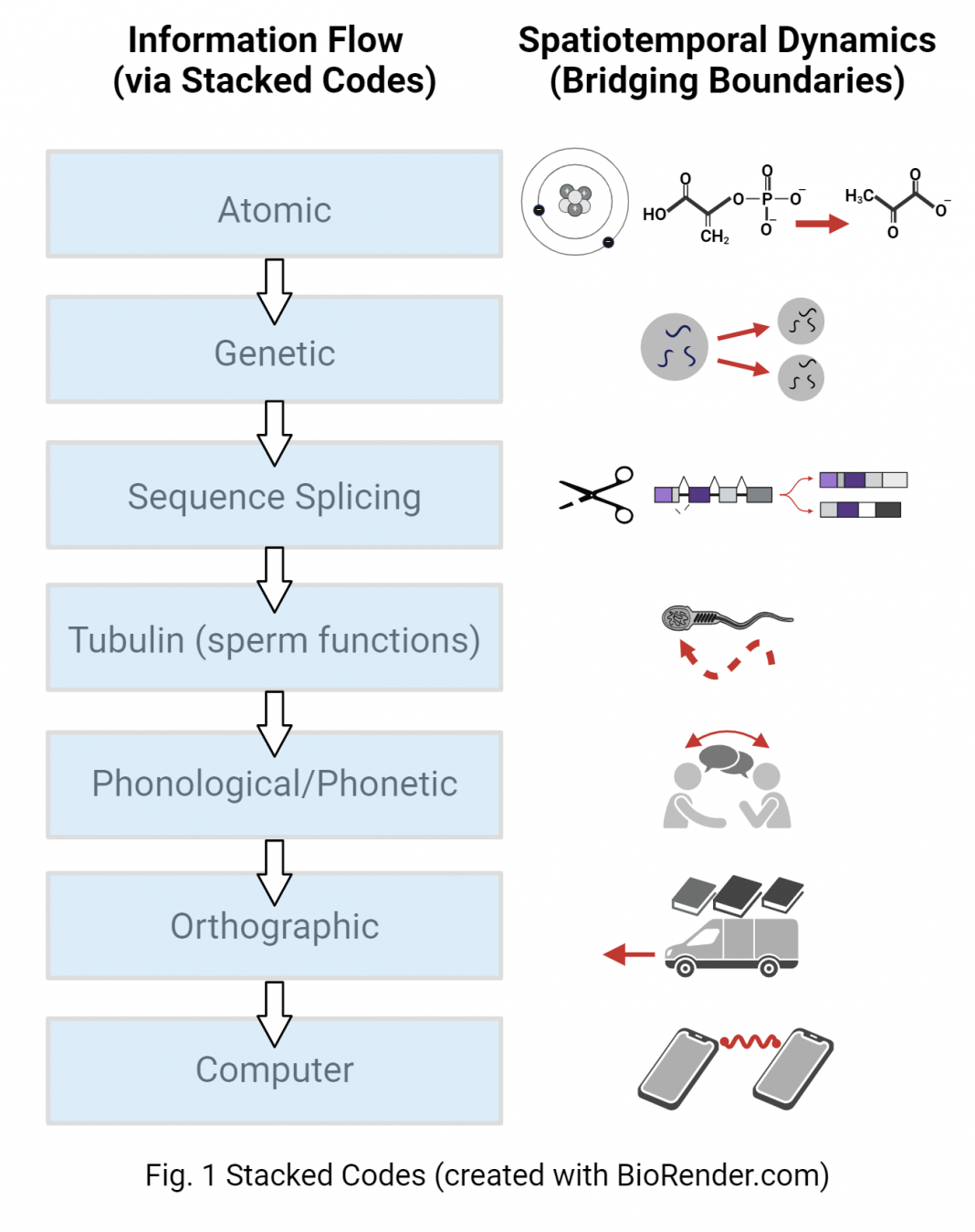Chris Girard from Florida International University, sheds light on how, in the digital age, stacked genetic, computer, and quantum codes are being edited by university-trained experts
New forms of complex organisation emerge at the edge of chaos (see Kauffman 1993; Wolfram 2002). The longevity of these emerging complex systems depends on their capacity to counter two chaos-sustaining (entropic) constraints: one is spatiotemporal, the other is energetic (Girard 2020, 2024). Countering such constraints occurs through flows of coded information that systematically translate the spatiotemporal and energetic dynamics of one domain into corresponding dynamics in another domain.
For example, atomic code translates the dynamics of charged subatomic particles (ie, numbers of high-speed electrons, etc) into the dynamic properties of matter’s building blocks. These blocks are then assembled based on molecular formulas. Genetic code transforms chromosomal dynamics into a biochemical process for assembling proteins. Computer code translates human oral and written information streams into digitised information flows (Fig. 1). At each level of complexity, code-guided triple flows – information streams, spatiotemporal dynamics and energy conversion – counter impending chaos that causes complex systems to collapse (Girard 2020).
Stacked codes are central to the tri-flow dynamics of our universe. In the digital age, stacked genetic, computer and quantum codes are being edited by university-trained experts. These experts must collaborate globally to create and understand complex codes. Universities, think tanks and research teams are progressively drawn toward “coopetition” as the complexity of code increases. Yet a backlash is forming against globalising digitalisation and transnational professionalism.
At stake are jobs based on motor skills, demographic and cultural homogeneity in ethnic homelands, and the political leverage of tradition-bound oral culture (Girard 2020). Stacked codes invariably confront such counterforces.
Boundary-bridging genetic code frees life from hydrothermal vents
The origin of contemporary digital-era codes can be traced back about four billion years, when genetic code likely evolved in ultramafic rock compartments in hydrothermal vents.
Within these rock pores, lipid vesicles evolved to house genetic material. These vesicles or protocells likely migrated via non-flagellar propulsion. Bridging spatial boundaries, the transmission of genetic code through protocell replication and migration freed life from confinement in hydrothermal vents (See Girard 2024).
Sex bridges boundaries between organisms
Two billion years later, sex first emerged after additional codes had been stacked (eg, sequence-splicing code in eukaryotic cells). Significantly, sexual reproduction does not split an already mature, spatially contiguous organism. The rigid spatial linkage in nonsexual reproduction is overcome by exchanging genetic code among spatially separated chromosomes and parents. By bridging spatiotemporal boundaries between organisms in the same species, sex recombines genetic instructions to generate new adaptive features (see Girard 2024).
Boundary-bridging phonological and orthographic codes
Approximately 50,000-400,000 years ago, phonological-to-phonetic coding transformed brainwaves into a motor response that created speech. For reading and writing that came later, a letter string in the form of orthographic code was translated into phonological code and vice-versa (Fig. 1). These codes enabled cooperation among spatially dispersed individuals who may have been hunting, fighting or fleeing, thereby reducing threats from the fastest, strongest and largest animals and human competitors.
Moreover, by overcoming death’s destruction of information stored in an individual’s cortex, the bridging of the body’s boundaries by oral and written culture allows cross-generational cumulation of knowledge (Girard 2024).
Based on phonological code, vocal sounds travel exclusively within hearing range. Longer-distance communication becomes possible with the emergence of boundary-bridging orthographic code. This code allows words to appear in an enduring visual field outside our bodies, distinct from vocal sounds that enter our heads and then vanish (Ong 2002). Accordingly, orality must conserve narratives, whereas orthographically coded information in books and articles fosters growth in human capital. Printed words enable mass schooling from elementary schools to universities (Allen 1991; Davis 1962). As schooling and literacy grow, skills formerly learned on the job come to depend more on formal education.
Digitalised boundary bridging
At present, code-enabled digitalisation and cloud technology allow instantaneous communication between computers, regardless of location. Hypertext links eliminate time-consuming searches through indexes, reams of paper and bookshelves (Fig.1).
Moreover, as the digitalised knowledge economy increases the demand for university degrees, labour market returns for cognitive skills have grown alongside diminishing returns for motor skills. The shifting market has contributed to a backlash from less metropolitan and less educated sectors, especially in locales where motor skills predominate.
Experts bridging global boundaries face heartland pushback
When traditions and oral narratives rather than evidence-based learning constitute the primary source of identity, ethnic groups tend to exercise non-negotiable control over their homeland turf. Establishing restrictive boundaries for a specific site reduces competition for resources and reduces uncertainty regarding access (see Meagher 2014; see Johnson and Toft 2013).
On the other hand, computer science experiments indicate that nonlocal adaptation – the capacity to cope with new situations – is increased when competitors feed on each other’s adaptative advancements (Mayfield 2013). Consequently, a system’s greater complexity makes adaptive capacity depend less on restrictive territorial boundaries and more on the collaborative diversity, depth and speed of code-based information processing.
In the digital age, oral culture’s tradition-bound entitlements are threatened by a knowledge-wielding expert class that depends on collectively studying and implementing complex code. Boundary bridging within this class entails the exchange of technical expertise in global epistemic communities (Haas 1992). The leverage of these epistemic communities grows with the world’s collaborative use of stacked codes.
References
- Allen 1991 https://archive.org/details/inpubliceyehisto0000alle
- Davis 1962 https://doi.org/10.3102/00346543032002127
- Girard 2020 https://link.springer.com/article/10.1007/s40844-019-00152-2
- Girard 2024 https://doi.org/10.1016/j.biosystems.2024.105133
- Haas 1992 http://www.jstor.org/stable/2706951
- Johnson and Toft 2013 https://doi.org/10.1162/ISEC_a_00149
- Kauffman 1993 https://doi.org/10.1093/oso/9780195079517.001.0001
- Mayfield 2013 https://ebookcentral.proquest.com/lib/fiu/detail.action?docID=1103442
- Meagher 2014 http://digitalcommons.uconn.edu/dissertations/469
- Ong 2002 https://archive.org/details/oralityliteracyt0000ongw
- Wolfram 2002 http://www.wolframscience.com/nks/

This work is licensed under Creative Commons Attribution-NonCommercial-NoDerivatives 4.0 International.


